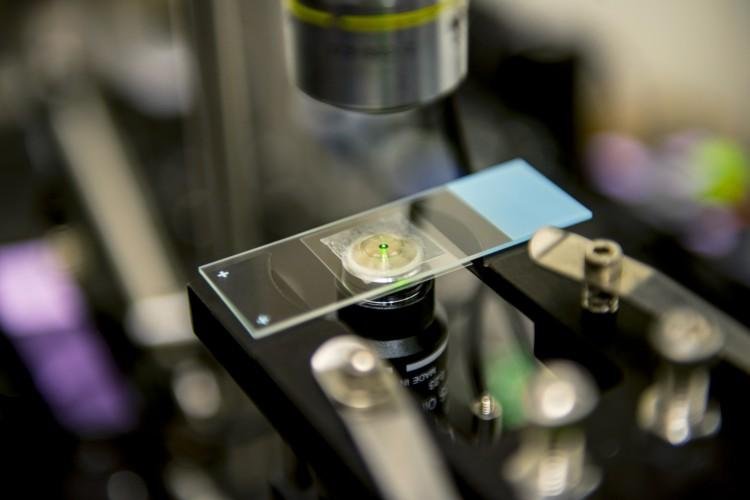The nanocrystal turns green as it cools. Photo by Dennis Wise/University of Washington
SEATTLE, Nov. 16 (UPI) -- Whether they're mounted on sharks or emanating from the Death Star, lasers can deliver destructive levels of heat. But scientists at the University of Washington have managed to cool water using a laser, the first time researchers have used the technology to create a refrigeration effect in a liquid.
Researchers created the laser beam by fixing an infrared laser light on a microscopic crystal suspended in liquid by a laser-powered tractor beam. The glow emanated by the laser-saturated crystal contained only slightly more energy than the amount of light absorbed by the crystal, extracting energy from the crystal and water.
The crystal was designed to change color as it cooled, allowing scientists to monitor whether or not their experiment was working in real time.
"The real challenge of the project was building an instrument and devising a method capable of determining the temperature of these nanocrystals using signatures of the same light that was used to trap them," researcher Paden Roder explained in a press release.
Roder is the lead author of a new paper on the discovery, published this week in the journal PNAS.
"The laser refrigeration process was first demonstrated in vacuum conditions at Los Alamos National Laboratory in 1995, but it has taken nearly 20 years to demonstrate this process in liquids," Roder acknowledged.
Currently, the process is rather energy intensive. But Roder and his colleagues hope to improve the technology so that it is scalable.
"Few people have thought about how they could use this technology to solve problems because using lasers to refrigerate liquids hasn't been possible before," Roder said. "We are interested in the ideas other scientists or businesses might have for how this might impact their basic research or bottom line."
One possibility would be to use the laser technology to slow down or silence biological processes. Slowing down the areas of the cell responsible for division and replication could allow scientists time to see and study these little-understand processes in real time.
Similarly, a single neuron could be frozen into silence using the laser's temperature-dropping glow. Researchers could then study how surrounding neurons and neural pathways adapt to its momentary absence.
"There's a lot of interest in how cells divide and how molecules and enzymes function, and it's never been possible before to refrigerate them to study their properties," said senior study author Peter Pauzauskie, an assistant professor of materials science and engineering at Washington.
"Using laser cooling, it may be possible to prepare slow-motion movies of life in action," Pauzauskie added. "And the advantage is that you don't have to cool the entire cell, which could kill it or change its behavior."















